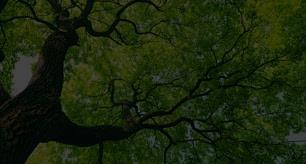Biophilic Design and the Possible Positive
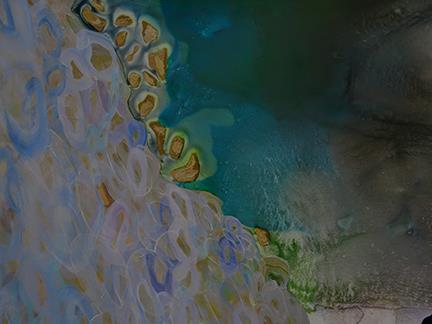
Effect Upon School Performance
Mihaela Dana Oprisan
Susan Antaki Khan
Directed Research ID 595A Fall 2019 Advisor:
Introduction
Biophilic design is based on the Biophilia hypothesis which proposes that humans have an innate connection with the natural world and that exposure to the natural world is therefore important for human wellbeing
I thought it might be useful to search the scholarly literature and identify the relationships among biophilic elements of the environment and cognitive functions, stress relief, attention restoration and translate them into design solutions such as plants in the classroom, window view of nature, daylight, variable lighting, and symbolic features which give a sense of attachment to place.
Case studies have shown that playscapes are important for social, motor and cognitive development in children. The design elements associated with playscapes studied: boulders for climbing, loose parts for problem solving and trees displaying fractals which are found in nature and provide a sense of refuge and wellbeing.
A review of the literature showed studies such as Kaplan’s Attention Restoration Theory, (S. Kaplan, 1995; R. Kaplan & Kaplan, 1989) posited that plants and natural settings foster restoration from mental fatigue because they invoke involuntary attention, which allows the capacity for directed attention to rest and replenish.
My intent was to research those design elements that helped best to achieve attention restoration, improved cognition, and subsequently, improved achievement scores.
Purpose of the Study

A review of the evidence for Biophilic design will focus on the environmental psychology literature which has a long tradition in examining the potential healing benefits of exposure to nature and natural elements as found in Attention Restoration Theory posited by (Kaplan, 1989, 1995.)
This study will review evidence for biologic design in classrooms and playscapes and will focus on the psychology literature which has a tradition in examining the potential healing benefits of exposure to nature and the differences in the way individuals respond to nature. The study will also compare the different biophilic elements in the classroom and playscape areas that may have a positive impact upon the executive functions, subsequent improvement in achievement scores and socialization among young students
The purpose of this study then is to compare the different biophilic design elements that could contribute to improved performance in the classroom and socialization amongst their peers. My intent is to translate research findings into feasible design solutions to create a stimulating and yet calming space within the classroom setting, indoor and outdoor playscapes.
LIGHT & SPACE

Glossary of Terms
BIOPHILIC DESIGN
NATURAL PATTERNS & PROCESSES ENVIRONMENTAL FEATURES
NATURAL SHAPES & FORMS
Achievement scores are often used in an educational system to determine the level of instruction for which a student is prepared. High achievement scores usually indicate a mastery of grade level material, and the readiness for advanced instruction. Wikipedia

Attention Restoration Theory asserts that people can concentrate better after spending time in nature or even looking at scenes of nature Widipedia
Behavior is the way in which one acts or conducts oneself, especially toward others.
Executive functions are a set of cognitive processes that are necessary for the cognitive control of behavior: selecting and successfully monitoring behaviors that facilitate the attainment of chosen goals. The Executive Functions: goal setting, self regulation, inhibitory control, initiation, working memory, planning, organization, decision making, problem solving, self monitoring. Wikipedia.
Fractals are a non-regular geometric shape that has the same degree of non-regularity on all scales. Fractals are the kind of shapes we see in nature. Whats.com
Stress is a physical, mental, or emotional factor that causes bodily or mental tension. Stresses can be external from the environment, psychological, or social situations. MedicineNet.com

What is Biophilic Design?

Biophilic design is a design philosophy that encourages the use of natural systems and processes in the design of the built environment. Biophilic design is based on the Biophilia hypothesis by Stephen Kellert and Elizabeth Calabrese which proposes that humans have an innate connection with the natural world and that exposure to the natural world is therefore important for human wellbeing. Biophilic design then suggests that environments could be made more restorative by incorporating natural elements in built environments.
Gillis, K., and Gatersleben,
Biophilic Design and the Possible Positive Effect Upon School Performance, Grad. Student Susan A. Khan, A. Literature Review, Data Analysis & Conclusions: A. Definition of Biophilia
Which are the design elements that have been shown to have a positive impact upon executive functions?

RESEARCH QUESTIONS
I expect to find specific design elements in the studies that will provide evidence that shows improved executive functions when biophilic elements are added to the environment.
Which are the design elements have been shown to have a positive impact on school performance?
I expect to find specific design elements that will have a positive impact upon school performance.
Which biophilic elements have been shown to improve mood?
I expect to find specific design elements that will have a positive impact upon mood and well-being.
Biophilic Design and the Possible Positive Effect Upon School Performance, Grad. Student Susan A. Khan, . A. Literature Review, Data Analysis & Conclusions A2 Research Questions

KEYWORDS:DATABASES:
Psychological
METHODOLOGY
PubMed
Google Scholar
Library Article Search
Cognitive Stress
Classroom Achievement
Attention Restoration Executive Functions
Mood
Well-Being
Biophilic Design Elements-Classroom
Daylight Variable Lighting Symbolic Features Plants/Living Wall
Window View of Nature
Biologic Design Elements-Playscape
Plants
Trees Nature Playscape Natural Plantings
Natural Shapes
Water Feature
LIST OF JOURNALS:
Children, Youth & Environments
Environment and Behavior
Journal of Environmental Psychology
Behavioral and Brain Sciences
Health Environments Research & Design Journal
Frontiers in Psychology
Affect Disorder
The International Journal of Play Youth and Environments
International Journal of Engineering Education Journal of Speech, Language, and Hearing Research
The articles selected for review were chosen for their relevancy regarding the cognitive, behavioral and achievement areas that were being investigated. Articles were deemed most relevant when the studies included the measures of impact of biophilic design features such as nature views, colors of nature, use of symbolic features such as artwork and natural elements in playscapes. Exclusion criteria included those articles not related to environmental psychology and/or the built environment.
Biophilic Design and the Possible Positive Effect Upon School Performance, Grad. Student Susan A. Khan, A. Literature Review, Data Analysis & Conclusions: A. 3 Methodology
INCLUSION CRITERIA BASED ON BIOPHILIC ELEMENTS OF THE ENVIRONMENT:
METHODOLOGY
Children between the ages of 5 12 were included in the study.
Peer-reviewed journals were utilized to answer the research questions posed. Biophilic elements that addressed the cognitive and achievement scores in elementary school aged children.
Studies were deemed relevant if the methodology used was thorough and controlled for a number of variables.
DATA ANALYSIS & DATA BASES

INCLUSION CRITERIA BASED ON PSYCHOLOGICAL IMPACTS:
Studies included research into the effect that biophilic design elements had on mood and wellbeing.
Studies that investigated the effect of biophilia in the classroom on cognition including the executive functions, behavior and stress levels were included.
Studies were deemed relevant if the methodology used was thorough and controlled for variables.
The data was captured, organized and calculated in an Excel program.
Data was extrapolated according to each topic explored such as behavior or stress and placed in graphs and tables delineating the different variables.
Based on data collected, conclusions were made with a high degree of confidence related to the methodology of the studies and their findings. In reviewing the research, I looked for the correlation between design elements and psychological outcomes.
Biophilic Design and the Possible Positive Effect Upon School Performance, Grad. Student Susan A. Khan, A. Literature Review, Data Analysis & Conclusions: A. 3 Methodology
FINDINGS
There were 35 studies selected for review and 25 were found relevant for this study. The six Biophilic design attributes that were used in this experience include: Form, Scale, Color, Texture, Pattern and Light. These studies were conducted within the school environment either in the classroom, in an outdoor setting on school grounds and in playscapes.
The studies were evenly divided between indoor and outdoor experiences: There were 14 studies reviewed that addressed the impact of Biophilic Elements on the executive functions compared to four for achievement scores.
When individual design elements were measured for the impact on executive functions, behavior, achievement scores, attention restoration and stress in the classroom the following design elements had a notable to significant positive effect upon the executive functions and achievement scores. These design features included:
When individual design elements were measured for the impact on executive functions, behavior, achievement scores, attention restoration and stress in the playscape settings the executive functions and socialization among classmates were most positively significantly impacted. These design features included:
--Window View of nature --Plants/Living Walls --Variable Lighting --Natural Daylight --Symbolic Features
-Challenges -Pathways-Bridges -Loose Parts-Logs,Twigs -Canopy of Trees -Unmanicured Gardens -Hiding Places -Greenery
Bar Graphs 1-6 illustrate the design elements showing a correlation between cognitive functions and the number of studies that were conducted investigating these functions.
Biophilic Design and the Possible Positive Effect Upon School Performance, Grad. Student Susan A. Khan, A. Literature Review, Data Analysis & Conclusions: A. 4 Findings
Biophilic Design and the Possible Positive Effect Upon School Performance, Grad. Student Susan A. Khan, A. Literature Review, Data Analysis & Conclusions: A. 4 Findings a. Graphs FINDINGS 0 1 2 3 4 5 6 7 8 Question #1: Do Biophilic Elements Improve Executive Functions Question #2-Do Biophilic Elements Improve Achievement Scores Number of StudiesAnswering Question #1 Compared to Question #2 12 11 -1 1 3 5 7 9 11 13 15 Indoor Outdoor Indoor vs. Outdoor Studies Reviewed EXECUTIVE FUNCTION BEHAVIOR ACHIEVEMENT SCORES 0 2 4 6 8 10 12 14 16 Number of StudiesAddressing Biophilic Elements Across Cognition Categories Graph 1 Graph 2 Graph 3 Graph 4 0 5 10 15 20 25 30 Cognition Restoration Stress Number of StudiesAddressing Biophilic Elements Across Cognition,Attention Restoration and Stress
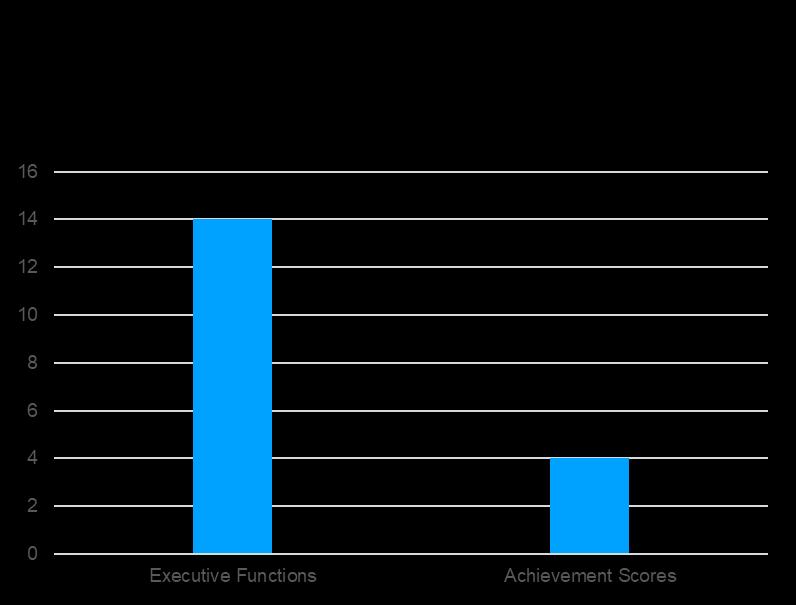
0 2 4 6 8 10 12 14 16 18 Question #1Do Biophilic Elements Improve Executive Functions Question #2 Do Biophilic Elements Improve Achievement Scores Indoor and Outdoor Combined Biophilic Elements and Impact on Executive Functions vsAchievement Scores Question #1: Do Biophilic Elements Improve Executive Functions Question #2-Do Biophilic Elements Improve Achievement Scores 0 1 2 3 4 5 6 7 8 9 10 Playscape Biophilic Effects on Executive Functions vs. Achievement Scores 0 1 2 3 4 5 6 7 8 Question #1: Do Biophilic Elements Improve Executive Functions Question #2-Do Biophilic Elements Improve Achievement Scores Classroom Biophilic Effects on Executive Functions vs. Achievement Scores Graph 5 FINDINGS Graph 6 Graph 7 Graph 8 Biophilic Design and the Possible Positive Effect Upon School Performance, Grad. Student Susan A. Khan, A. Literature Review, Data Analysis & Conclusions: A. 4 Findings a. Graphs
Window View of Nature
(Langdon &Loudon, 1970) found decreased academic performance and hormone level differences associated with windowless classrooms. Students in classrooms with larger window areas scored higher in mathematics and reading when compared with those in classrooms with smaller windows and less access to light. (Heschong Mahone Group, 1999, 2003) Students with a natural view rated the course curriculum, classroom resources, and classroom materials more positively than students with no natural view. (Benfield, J., 2015.)
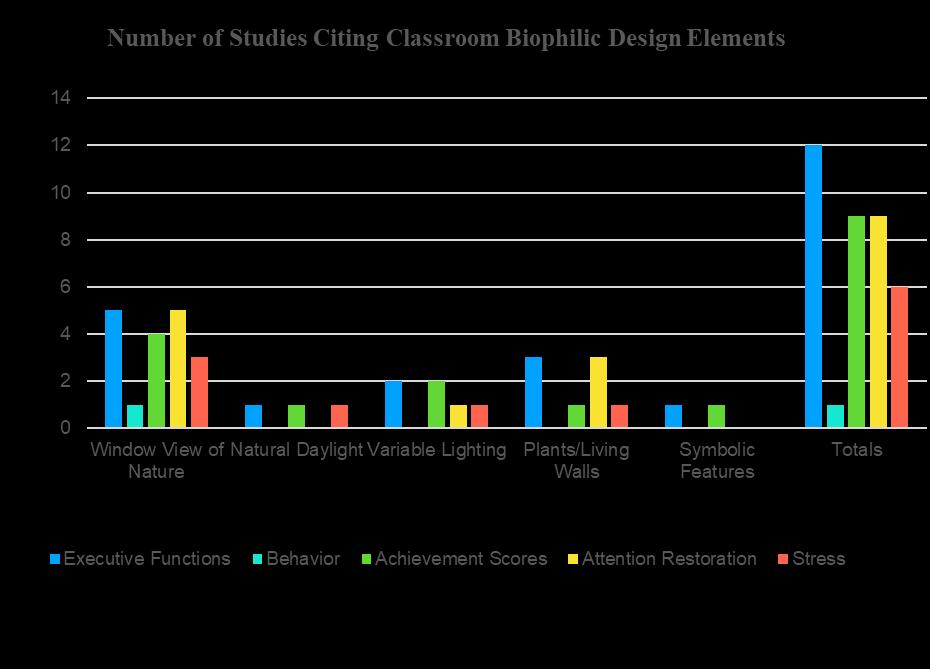
Natural Daylight
From a Biophilic view, humans evolved under natural light conditions A study on children in a classroom in Sweden found that children in rooms with daylight had improved attention when compared with children in classrooms with no windows and conventional fluorescent lighting. (Kuller, R., 1992.)
Variable Lighting
Dynamic lighting refers to lighting that provides varying lighting parameters that vary over time to support user activities. Daylight spectrum lighting that changes throughout the day to mimic natural light, such as circadian lighting, could be a way to better reap the benefits of natural light. Research on the correlation between the color of illumination and student performance has been shown to be positive. Students’ attention has been shown to increase when lighting with higher CCT (color temperature as a measure of Kelvins) values is used and that students’ levels of relaxation and calmness are increased by lighting to set to lower CCT values (Choi, K, 2016 )
Plants in the Classroom
Numerous studies have shown that indoor plants provide benefits for health and wellbeing In a study performed by John Daly, 2010 at the University of Technology, Sydney, found that classroom plants consistently led to improved performance in spelling, mathematics and science, and across the curriculum
Symbolic Features
Symbols such as artwork and posters inform students whether they are valued learners and belong within the classroom with far reaching consequences for students’ educational choices and achievement Work in psychology and education has demonstrated the importance of environmental features that we term the symbolic classroom. Far from being trivial details, these features powerfully affect classroom culture The objects present in a classroom influence performance and shape student aspirations (Fisher, Godwin, & Seltman, 2014). Small changes to the symbolic classroom can improve learning outcomes for all students and help reduce racial and gender achievement gaps ( Cheryan, S , Ziegler, A ,Plaut, V., and Meltzoff, A. 2014.)
Biophilic Design and the Possible Positive Effect Upon School Performance, Grad. Student Susan A. Khan, A. Literature Review, Data Analysis & Conclusions: A. 4 Findings a.Graphs
FINDINGS

NATURAL DAYLIGHT X X X X VARIABLE LIGHTING X X ATTENTION RESTORATION IMPACT ON STRESS GREEN-LOOSE PARTSPATHWAYS-FRACTAL TREE PLANTS - LIVING WALLS X X X X PSYCHOLOGICAL IMPACT BIOPHILIC FEATURE X X EXECUTIVE FUNCTION BEHAVIOR ACHIEVEMENT SCORES X=Positive Correlation Biophilic Design and the Possible Positive Effect Upon School Performance, Grad. Student Susan A. Khan, A. Literature Review, Data Analysis & Conclusions: A. 4 Findings b.. Tables CLASSROOM PLAYSCAPE TABLES SHOWING THE PSYCHOLOGICAL IMPACT OF STUDIED ELEMENTS IN THE SELECTED STUDIES
CONCLUSIONS
A review of Biophilic design elements that demonstrated a positive impact upon cognition, specifically the executive functions and achievement scores in school-aged children, variable results demonstrating the benefits of Biophilic design for increasing performance in the classroom and playscape environments.
When determining the effect of all design features when taken together, executive functions were impacted very significantly, achievement scores and attention were impacted as well but less significantly. These findings were found to be relevant for designing a classroom space and indoor and outdoor playscapes.
The studies were conducted in various schools around the country and internationally. Children, whose executive functions are in the process of developing until they are into early adulthood, would appear to benefit greatly from these small changes within the classroom environment. If these cognitive skills, which have been shown to have a positive impact on higher critical and abstract thinking skills continue to strengthen throughout the elementary school years then an inference could be made that with biophilic elements such as plants in the classroom, window views of nature, artwork and posters that provide a sense of place and attachment, that students will continue to expand their cognitive abilities and subsequently demonstrate improved achievement into the upper grades.
Future research is needed to isolate and control for different design elements and their correlation with various cognitive functions. There has been little research on the various combinations of proposed attributes that have been covered in this study. For example, do plants and certain materials have a larger impact than plants in the classroom and nature views? Is gender a factor in how design elements impact cognition and achievement?
The research in studying how children socialize and develop higher critical thinking skills has been well researched in the area of developing playscapes with specific design elements but not as extensive in the classroom setting. Future research is needed to explore whether these skills are maintained throughout adolescence.
Biophilic Design and the Possible Positive Effect Upon School Performance, Grad. Student Susan A. Khan, A. Literature Review, Data Analysis & Conclusions A. Conclusions
EXECUTIVE
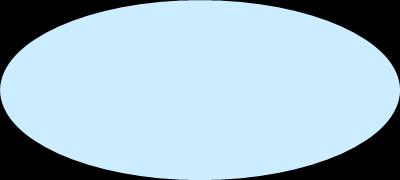

IMPROVED SCHOOL




COGNITION
FUNCTIONS STRESS RELIEF ATTENTION RESTORATION PLANTS IN CLASSROOM WINDOW VIEW OF NATURE DAYLIGHT VARIABLE LIGHTING SYMBOLIC FEATURES CONCEPTUAL MODEL
PERFORMANCE BIOPHILIC ELEMENTS Biophilic Design and the Possible Positive Effect Upon School Performance, Grad. Student Susan A. Khan, A. Literature Review, Data Analysis & Conclusions A5. Conclusions
Amicone, G.1, Petrucelli, I. 2, DeDominicis, S. 3, Gherardini, A. 4 (2018). Green Breaks: Restorative Effect of the School Environment’s Green Areas on Children’s Cognitive Performance. Frontiers in Psychology, 9, 1579
Benfield, J., Rainbolt, G. (2015). Classrooms with Nature Views: Evidence of Differing Student Perceptions and Behaviors. Environment and Behavior, 47(2), 140 157.
Berman, M., Kross, E., Krpan, K., Askren, M., Burson, A. et al., (2012). Nature Improves Cognition and Affect for Individuals with Depression. Affect Disorders, 140(3), 300 305.
Bourrier, S., Berman, M., Enns, J. (2018). Cognitive Strategies and Natural Environments
Interact in Influencing Executive Function. Frontiers in Psychology Environmental Psychology, doi:10.3389/fpsyg.2018.01248
Carr, V., Douglas, R., Brown, S., et.al., 2017. Nature by Design, Playscape Affordances
Support the Use of Executive Function in Preschoolers. Children, Youth and Environments, 27(2) 25 46.
Carr, V., Luken, E. (date). Nature Playscapes as Contexts for Fostering Self Determination. The International Journal of Play, 3(1), 69 83.
Chen, Z., Yujia, H., Yuguo, Y. (2013). Enhanced Functional Connectivity Properties of Human Brains During In Situ Nature Experience. SAGE Publications Peer J 4:e2210; DOI 10.7717/peerj.221.
Cheryan, S. Ziegler, S., Plaut, V., Meltzoff, A. (2014). Designing Classrooms to Maximize Student Achievement. Behavioral and Brain Sciences, 1(1) 4 12.
Kyungah, C., Hyeon Jeong, S. (2016). Dynamic Lighting System for the Learning Environment: Performance of Elementary Students. Optics Express, 24(10).
Dadvanda, P., Nieuwenhuijsena, M., Fornsa, J., Basagana, X. (2015). Green Spaces and Cognitive Development in Primary Schoolchildren. PNAS, 112(26), 7937 7942.
Daly, J., Burchett, M., Torpy, F. (2010) Plants in the Classroom Can Improve Student Performance Front. Psychology. https://doi.org/10.3389/fpsyg.2018.01669
Dockrella, J., Shield, B., (2012). The Impact of Sound Field Systems on Learning and Attention in Elementary School Classrooms. Journal of Speech, Language & Hearing Research, (55), 1163 1176.
Gillis, K., Gatersleben, B. (2015). A Review of the Psychological Literature on the Health and Wellbeing Benefits of Biophilic Design. Buildings 2015, 5(3), 948 963; https://doi.org/10.3390/buildings5030948
Klatte, M., Hellbruck, J. (2010. Effects of Classroom Acoustics on Performance and Well Being in Elementary School Children: A Field Study Environment and Behavior, DOI:10.1177/003916509336813
Kochanowski, L., Carr, V. (2014). Nature Playscapes as Contexts for Fostering Self Determination in Children. Youth and Environments 24(2), 146 167.
Kuo, M., Browning, M., Sachdeva, S., Lee, K., Westphal, L. (2018). Examining the Link Between “Greeness” and Academic Achievement in Urban, High Poverty Schools. Frontiers in Psychology, (25), doi.org/10.3389/fpsyg.2018.01669
Kuo, M., Browning, M., Penner, M. (2018). Do Lessons in Nature Boost Subsequent Classroom Engagement? Refueling Students in Flight. Frontiers in Psychology. Doi.org/10.3389/fpsyg.2017.02253
Llorca, J., Redondo, E., Vorla, M. (2019). Learning Room Acoustics by Design: A Project Based Experience. International Journal of Engineering Education, (35)1, 1 7. McGee, B., Marshall Baker, A., (2015). Loving Nature from the Inside Out: A Biophilia Matrix Identification Strategy for Designers. Health Environments Research & Design Journal, (8)4 115 130.
Mott, M., Robinson, D.H., Walden, A., et al. (2012). Illuminating the Effects of Dynamic Lighting on Student Learning. SAGE Open. Doi10.1177/2158244012445585.
Sleegers, P., Moolenaar, N., Galetzka, M., (2013). Lighting Affects Students’ Concentration Positively: Findings from Three Dutch Studies. Lighting Res. Technology, 45, 159 175.
Stenfors, C., VanHedger, S., Schertz, K., Meyer, F., et al. (2019). Positive Effects of Nature on Cognitive Performance Across Multiple Experiments: Test Order but Not Affect Modulates the Cognitive Effects. Frontiers in Psychology Environmental Psychology, 10, 1413. Doi:10.3389/fpsyg.2019.01413
Tennessen, C., Cimprich, B., (1995). Views of Nature: Effects on Attention. Journal of Environmental Psychology, 15, 77 85.
Torquati, J., Schutte, A., Kiat, J. (2017). Attentional Demands of Executive Function Tasks in Indoor and Outdoor Settings: Behavioral and Neuroelectrical Evidence. Children, Youth and Environments,27(2) 70 92.
Ulrich, R., Simons, B., Losito, B. (1991). Stress Recovery During Exposure to Natural and Urban Environments. Journal of Environmental Psychology, 11, 201 230.
Van den Berg, A., Wesselius, J. (2016). Green Walls for a Restorative Classroom Environment: A Controlled Evaluation Study. Environment and Behavior, 49(7), 1 23.
Biophilic Design and the Possible Positive Effect Upon School Performance, Grad. Student Susan A. Khan, A. Literature Review, Data Analysis & Conclusions: A. 4 Findings References
REFERENCES
REFERENCES NOT INCLUDED IN THIS STUDY
Berry, M., Sweeney, M., Morath, J., Odum, A., Jordan, K. (2014). The Nature of Impulsivity: Visual Exposure to Natural Environments Decreases Impulsive Decision Making in a Delay Discounting Task. PLoS ONE 9(5): doi: 10.1371/journal.pone.0097915
Berto, R. (2014). The Role of Nature in Coping with Psycho Physiological Stress: A Literature Review on Restorativness. Behav. Sci. 4 394 409.
Emfield, A., Neider, M. (2014). Evaluating Visual and Auditory Contributions to the Cognitive Restoration Effect. Frontiers in Psychology. doi: 10.3389/fpsyg.2014.00548
Ferguson, K., Cassells, R., MacAllister, J., Evans, G. (2013) The Physical Environment and Child Development: An International Review. International Journal Psychology, 48(4)437 468
Malinin, L., Parnell, R. (2012). Reconceptualizing School Design: Learning Environments for Children and Youth. Children, Youth and Environments, 22(1) 11 22.
Tsunetsugu, Y., Miyazaki, Y. (2007). Physiological Effects in Humans Induced by the Visual Stimulation of Room Interiors with Different Wood. J. Wood Sci. 53, 11 16.
Wolch, J., Byrne, J., Newell, J. (2014) Urban Green Space, Public Health, and Environmental Justice: The Challenge of Making Cities “just green enough.” Landscape and Urban Planning 125 234-244
DESIGN CONCEPT & SCHEMATIC DESIGN
KEY DESIGN WORDS
CLASSROOM
Natural Daylight
Lessons Outdoors
Water Features
Plants/Living Wall
Natural Geometries-Fractals
Symbolic Objects-Artwork, Posters
Cultural and ecological attachment to place
Natural Shapes-Oval, Rounded
Dynamic Lighting
INDOOR PLAYSCAPE & OUTDOOR PLAYSCAPES
Hiding Places
Lessons Outdoors
Reading Nooks
Loose Parts
Unmanicured Gardens
Unleveled topography
Semi-enclosed spaced & perimeter boundary

Canopy of trees
Challenges
Pathways
Twigs, tree cookies, logs
Water features
Sand, rocks, flowers
Effects: selected attention, directed attention, working memory, inhibitory control, self regulation, and increased attentiveness
The research studies informed the different design elements in the classroom space by incorporating:
· Colors of nature greens and blues
· Plants
· Natural materials sustainable hardwood floors such as bamboo, cork, oak
· Symbolic features posters to give a sense of place, artwork that is representative of nature
· Daylight and Variable Lighting switches to allow for changing lighting in the classroom to best suit the tasks at hand
The research studies informed the varying design elements in the indoor playscape:
· Seating for academic lessons taught in a natural setting
· Plants
Effects: initiation, self monitoring, inhibitory control, flexibility, working memory, problem solving socialization,
The design concept incorporated design elements that were found in the studies to be the most effective in improving executive functions significantly and to a lesser extent achievement scores. In several studies, students were surveyed about their satisfaction regarding certain elements such as plants in the classroom or challenges in the playscape and it was shown that students derived pleasure from these design elements but they overwhelmingly liked “lessons outdoors.”
· Comfortable seating to provide a sense of solitude or refuge
· Textures smooth coarse
The research studies informed numerous design elements in the outdoor playscape:
· Boulders and rocks for climbing rock wall
· Bridge
· Natural vegetation garden
· Sensory Wall
· Trees
The findings here provide some support and guidance for including more lessons in nature. Students simultaneously learned classroom curriculum while rejuvenating their capacity for learning by “restoring attention” more frequently which would help explain their enjoyment of this setting.
CLASSROOM
Design ElementPsychological Features FORM SCALE COLOR TEXTURE PATTERN LIGHT

Cognition
Stress
naturalrounded, oval, arc, directionality, *repetition, undulating, curvatures
*shapes resisting straight lines and right angles *bounded spaces blues & greens, neutrals
Behavior natural colors of nature
Achievement Scores
rounded, oval, arc, directionality
Daylight/VariableVaried-rough, smooth, sensory, tactile colors of nature, greens, blues, hues, strong & soft colors
*Integration of parts to wholes
smooth *dynamic balance & tension
*filtered & diffused light
*egg, oval & tubular forms *transitional spaces soft hues of nature colors *sensory variability *central focal point daylight, warm & low lighting
Varied-rough, smooth, sensory, tactile
*Integration of parts to wholes Daylight/Variable
Varied-rough, smooth, sensory, tactile Repetition, undulating, curvaturesAttention Restoration
*Spatial harmony natural colors of nature
*Stephen Kellert's Biophilic Design Elements & Attributes
Biophilic Design
the
A. Khan,
Daylight/Variable
DESIGN CONCEPT
and
Possible Positive Effect Upon School Performance, Grad. Student Susan
B. Design Concept & Schematic Design B1. Design Concept. Tables
*Stephen
CONCEPT
Biophilic
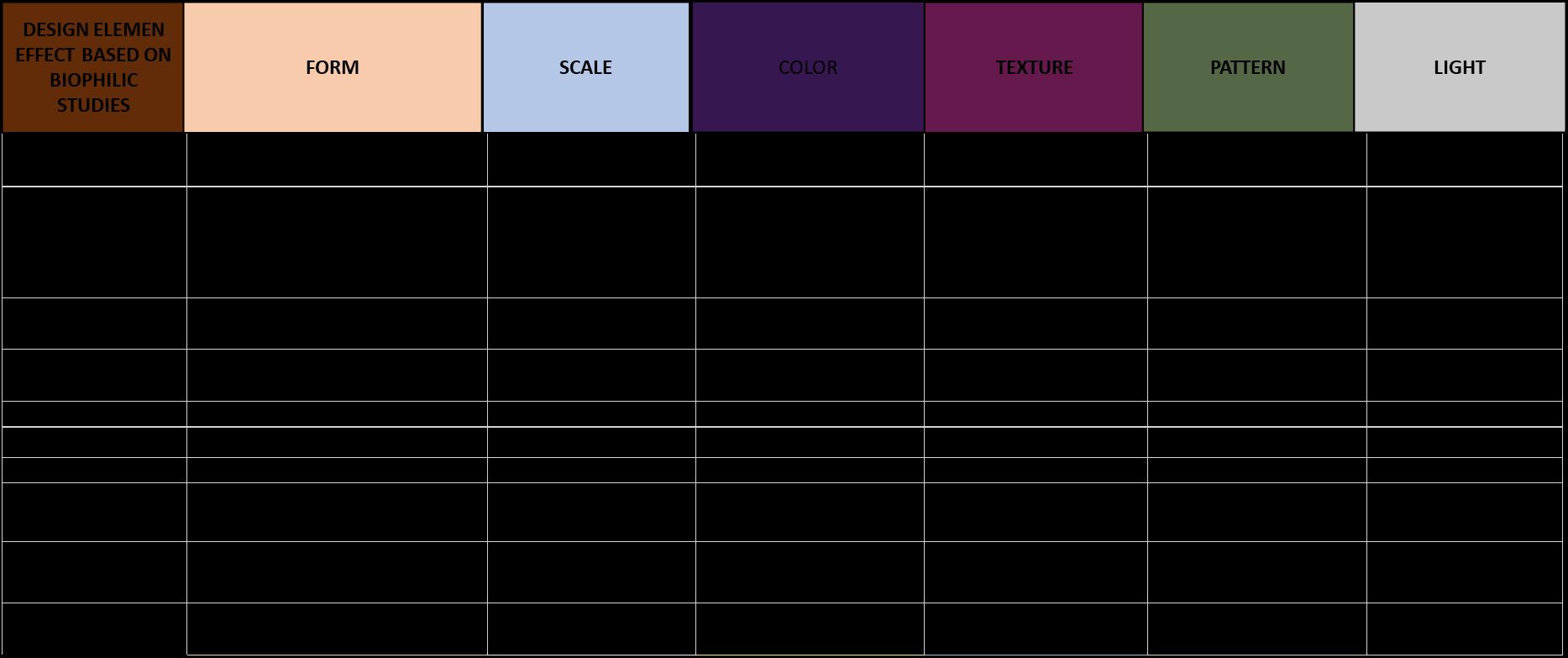

CLASSROOM
PLAYSCAPE
DESIGN
Kellert's Biophilic Design Elements & Attributes
Design and the Possible Positive Effect Upon School Performance, Grad. Student Susan A. Khan, B. Design Concept & Schematic Design B1. Design Concept. Tables
Design Steps
Programming - Design Concept - Schematic Design
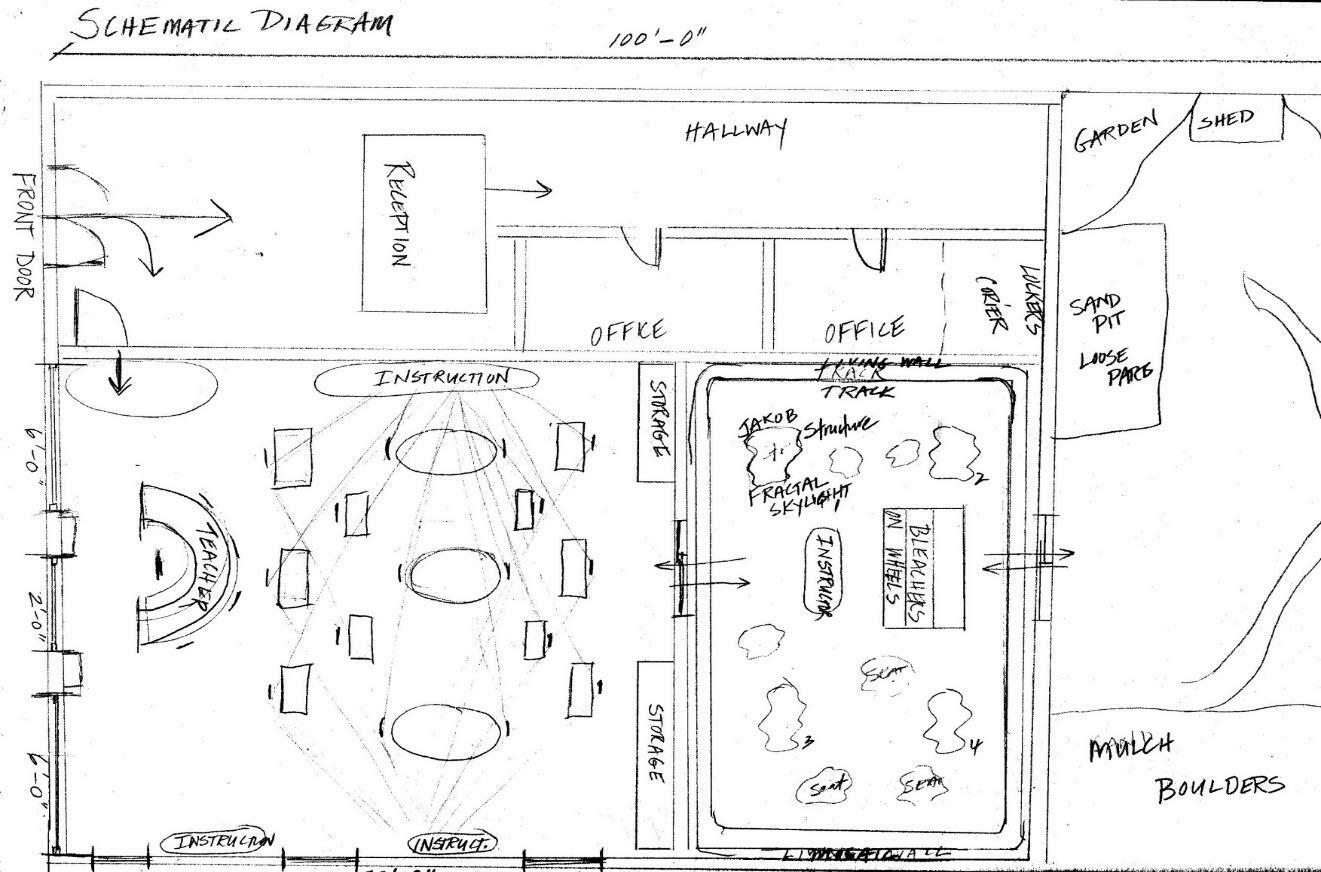
Design Development



-
Biophilic Design and the Possible Positive Effect Upon School Performance, Grad. Student Susan A. Khan, B1. Design Concept & Schematic Design B2. Programming SCHEMATIC DIAGRAM I SCHEMATIC DIAGRAM II CIRCULATION PLAN SITE
STUDY
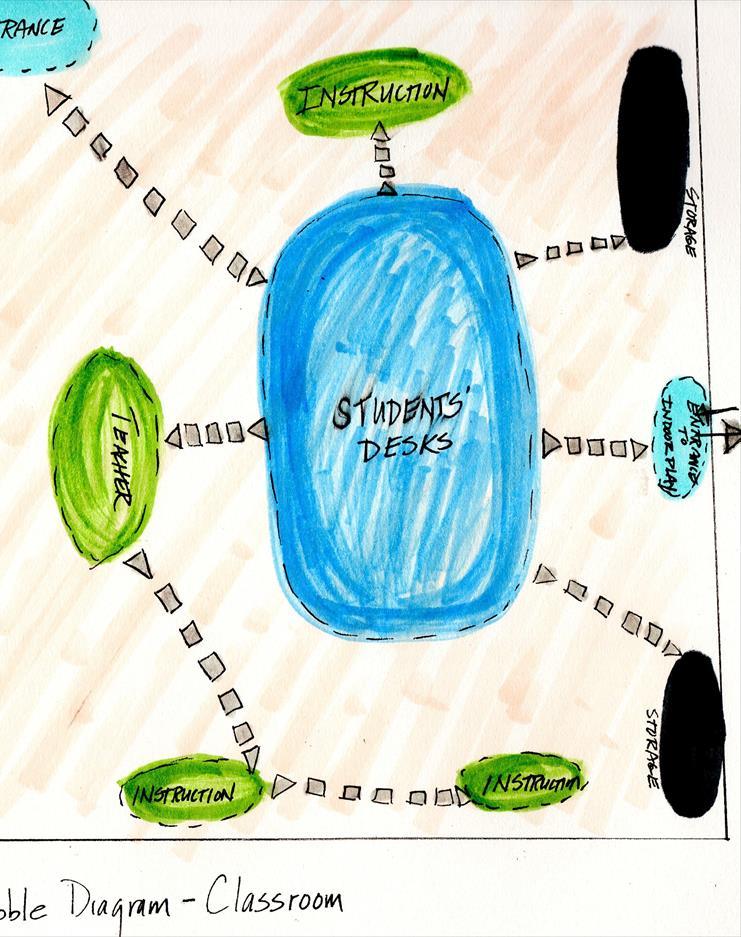

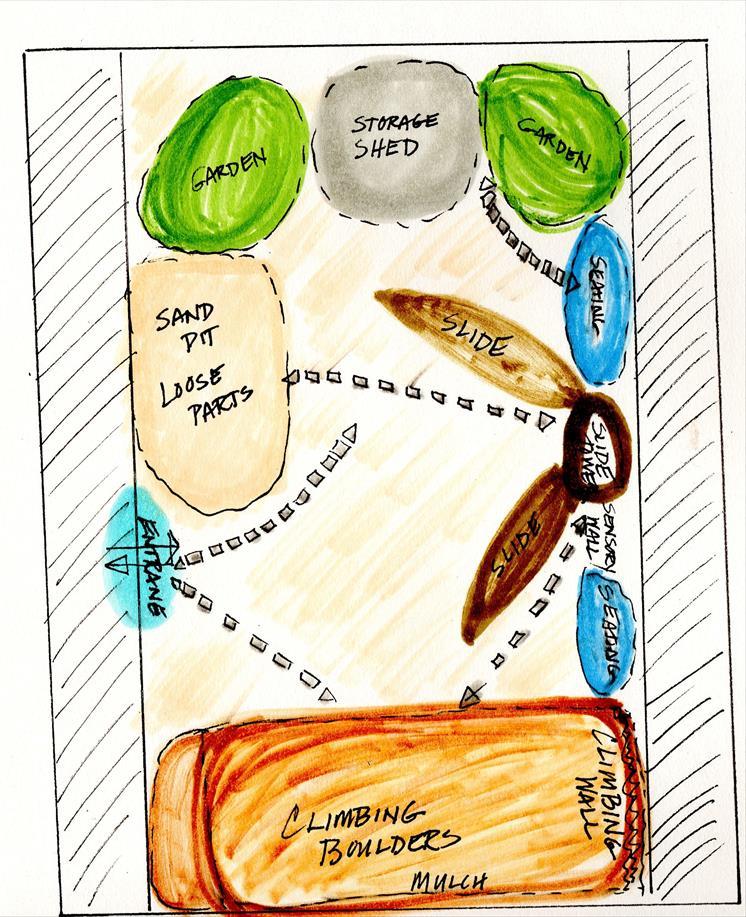
PROGRAMMING & BUBBLE DIAGRAMS Biophilic Design and the Possible Positive Effect Upon School Performance, Grad. Student Susan A. Khan, B. Design Concept & Schematic Design B 2 Programming and Bubble Diagrams INDOOR PLAYSCAPE OUTDOOR PLAYSCAPECLASSROOM
SCHEMATIC DESIGN DRAFTS-DESIGN INTENTIONS

This design example incorporates several of the biophilic design elements that I want to see in my design of a classroom and indoor playscape. It incorporates features such as wood which has been shown to have a soothing effect. The wood grain itself shows some fractal patterns and is repeated throughout nature.
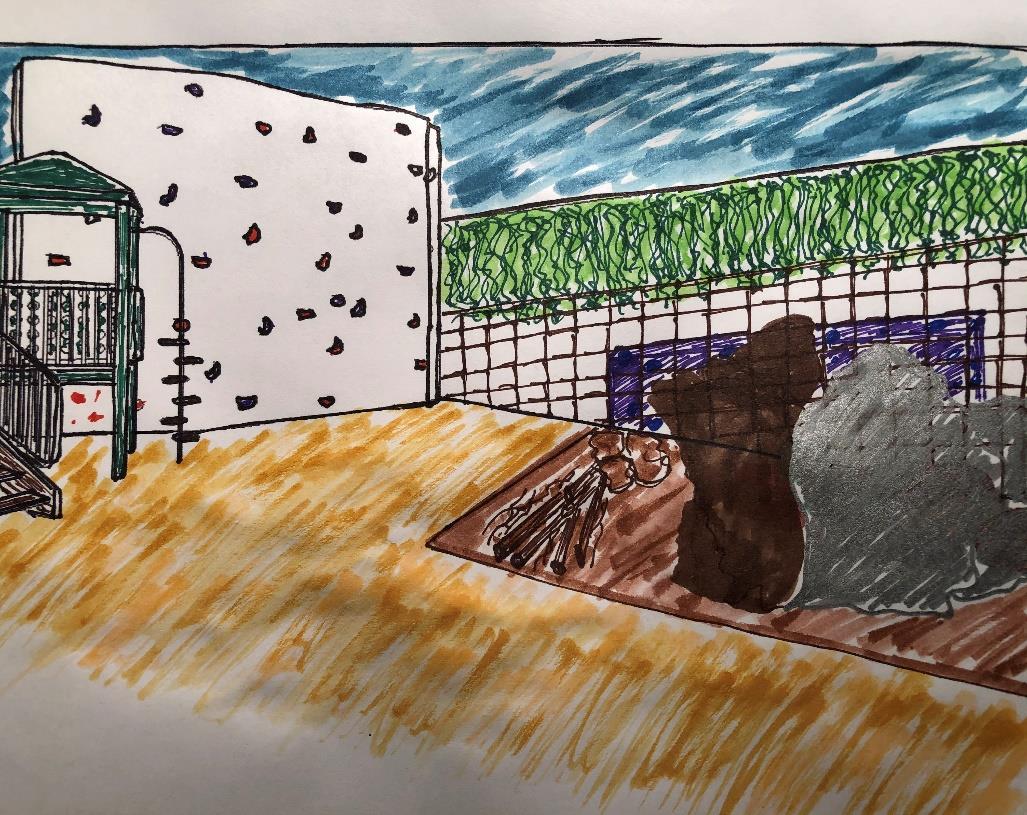
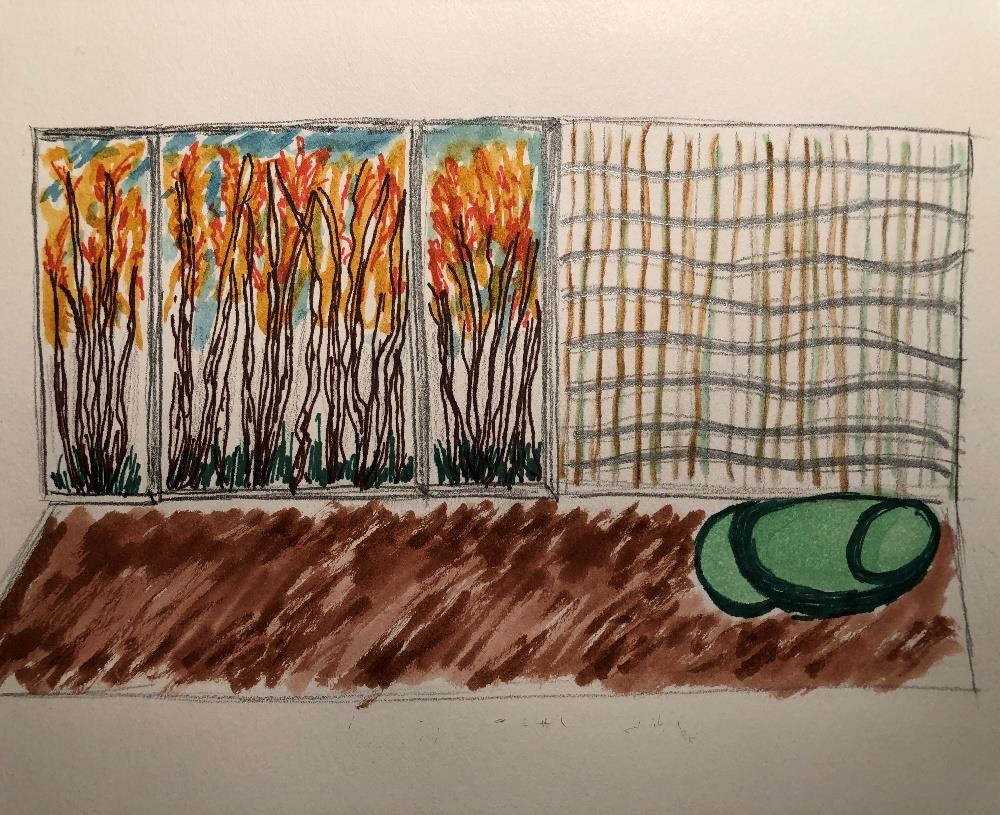
The color purple is stimulating and is contrasted with green which is restful. The cubbies allow for contemplation and privacy when needed. The trees in the background are a biophilic feature which display their pattern of fractals. Fractal patterns help connect us with nature on a biological level. The brain is predisposed to process them easily which lowers our stress response and helps to restore attention and decrease fatigue.
Each hexagon shaped cube is lined with Interface's Net Effect carpet, offering students an area of refuge. Photography courtesy of Interface.
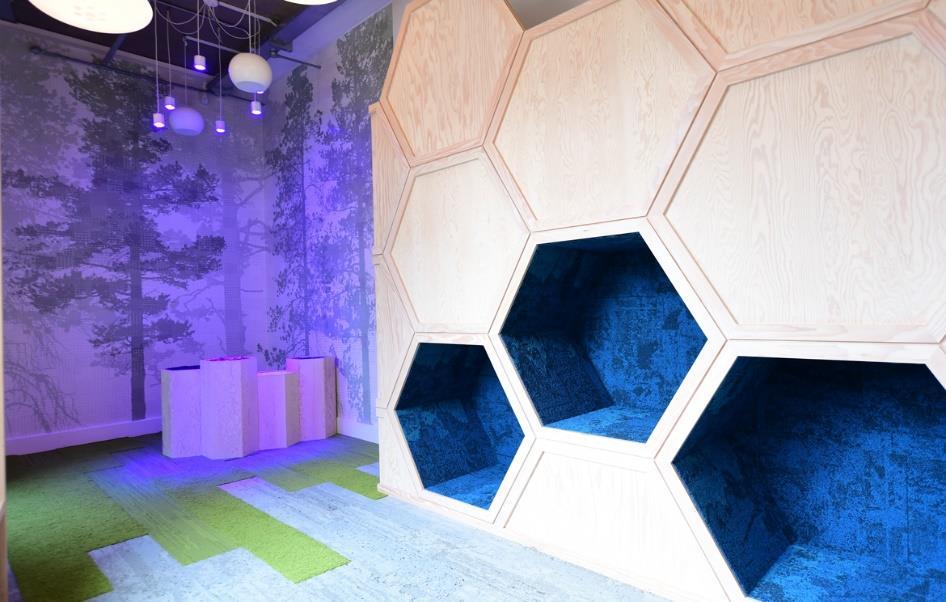
Biophilic Design and the Possible Positive Effect Upon School Performance, Grad. Student Susan A. Khan, B. Design Concept & Schematic Design B 3. Schematic Design Drafts with Notes
Hand
Sketch of indoor playscape wall Hand Sketch
of outdoor playscape
Hand Sketch of outdoor playscape

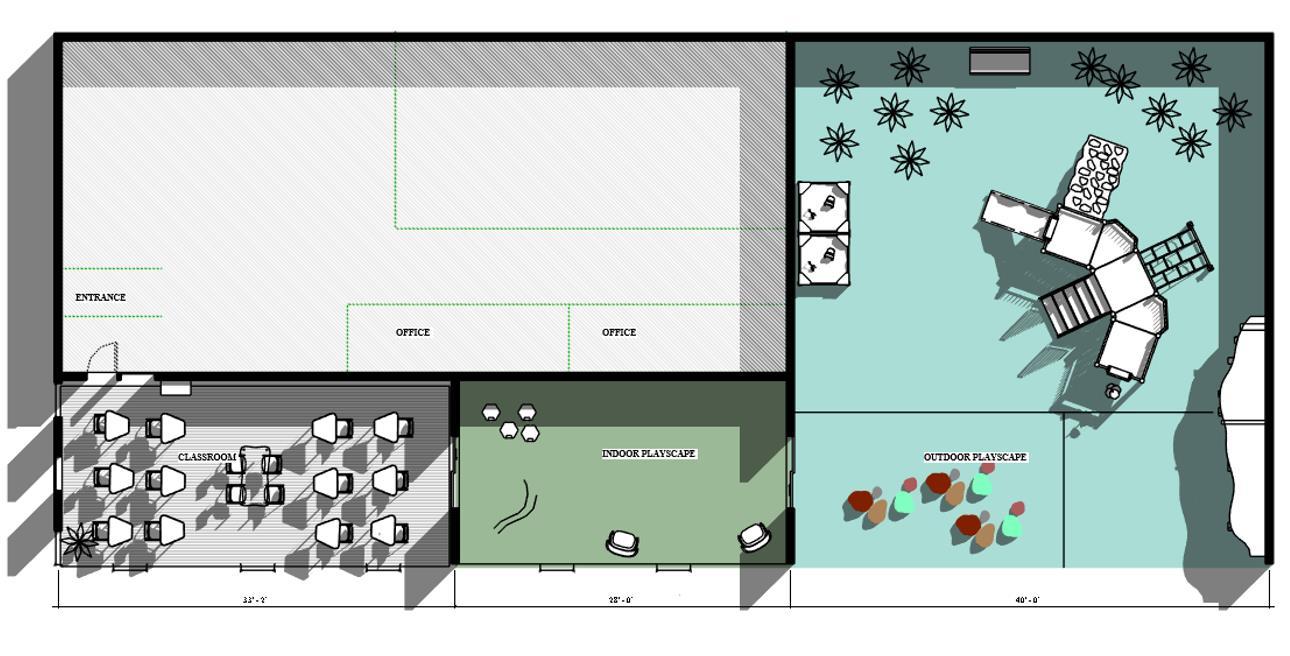
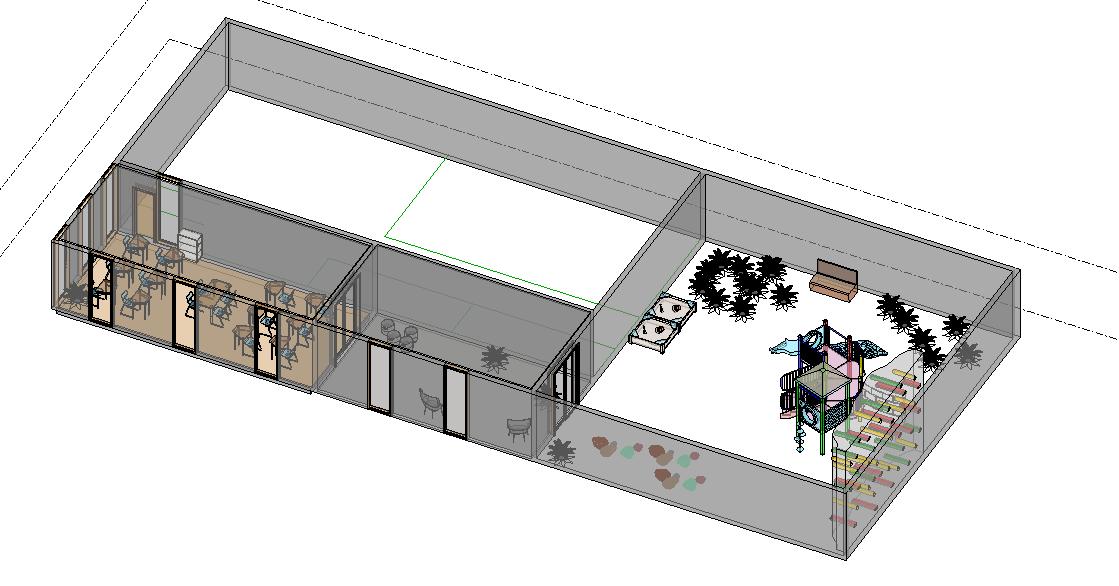

FINAL DESIGN DOCUMENTS
FLOOR PLAN FLOOR PLAN WITH SHADOWS
AXONOMETRIC
VIEW
ELEVATION Biophilic Design and the Possible Positive Effect Upon School Performance, Grad. Student Susan A. Khan C. Final Design Documents
CLASSROOM

Design elements incorporated based upon the design research for helping to improve executive functions and achievement scores included: rounded shapes, wooden floors, living walls, acoustical light rings, daylight, reduced glare, symbolic features such as map and posters depicting values and culture, artwork, window view of nature, living wall and contrasts in textures.

Biophilic Design and the Possible Positive Effect Upon School Performance, Grad. Student Susan A. Khan

C. Final Design Documents
Indoor playscape included biophilic design elements that were shown in the studies to have a positive impact upon executive functions and achievement scores. These elements included: hiding and private spaces, undulating walls of natural materials such as rattan, copper and wood, rounded shapes as seen in the chairs, pillows, challenging activities such as indoor rock climbing and living plants. These elements help to foster socialization skills and a sense of well being.
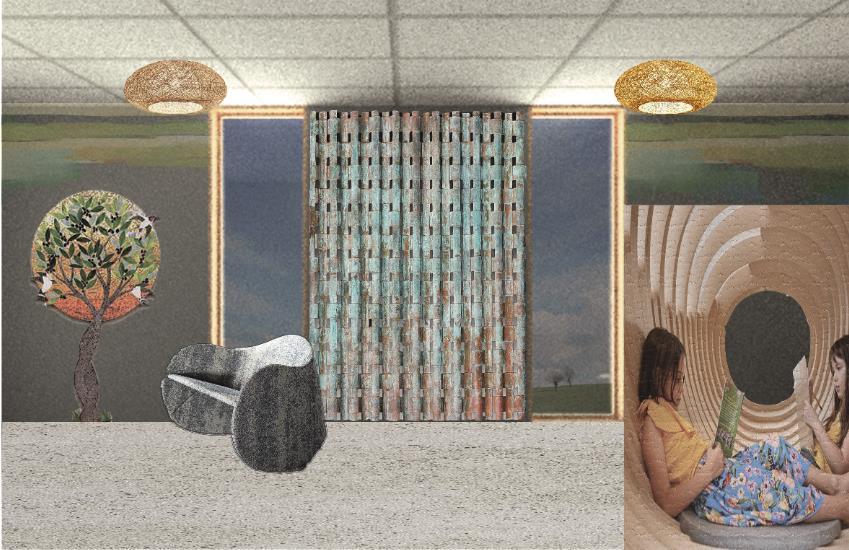
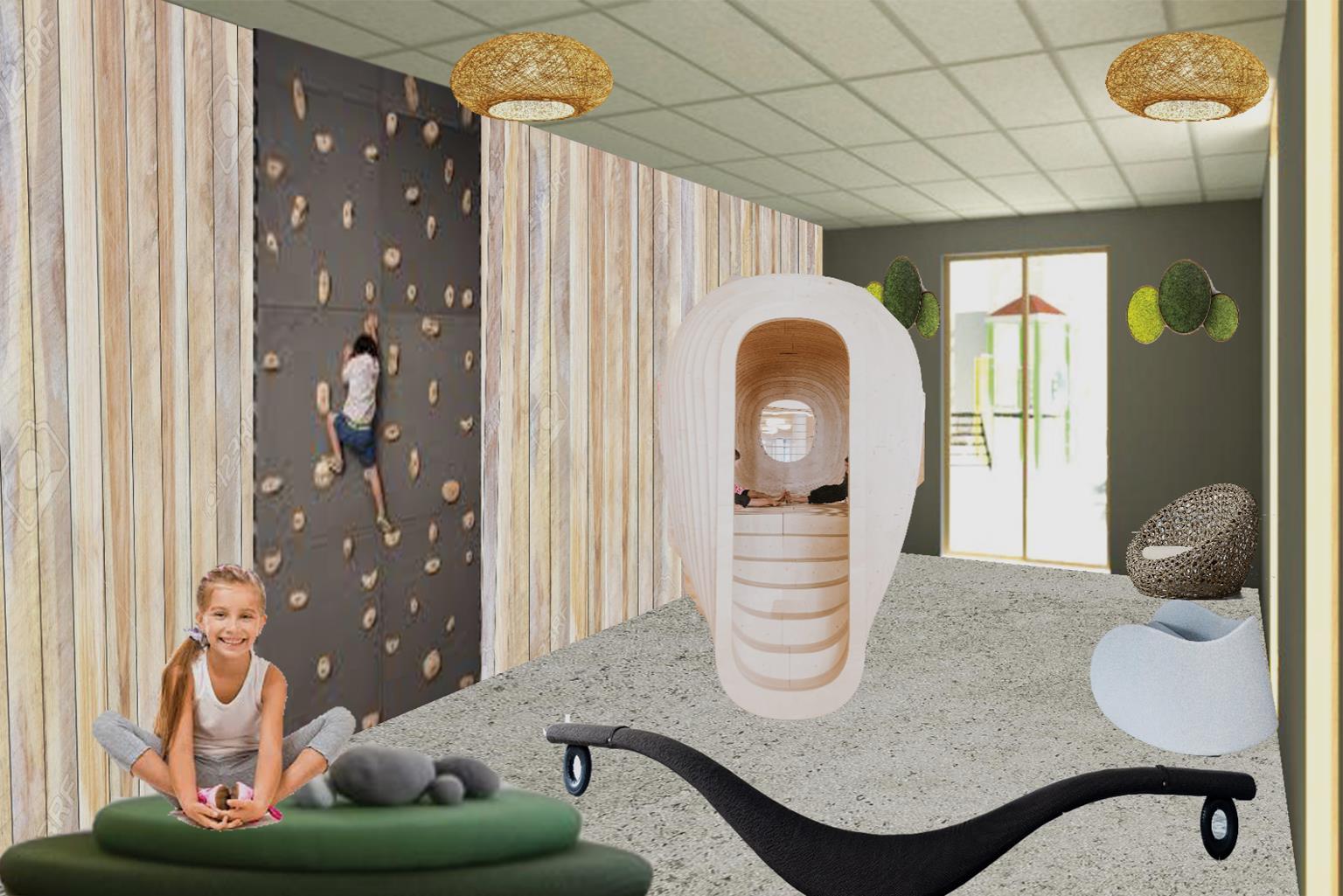
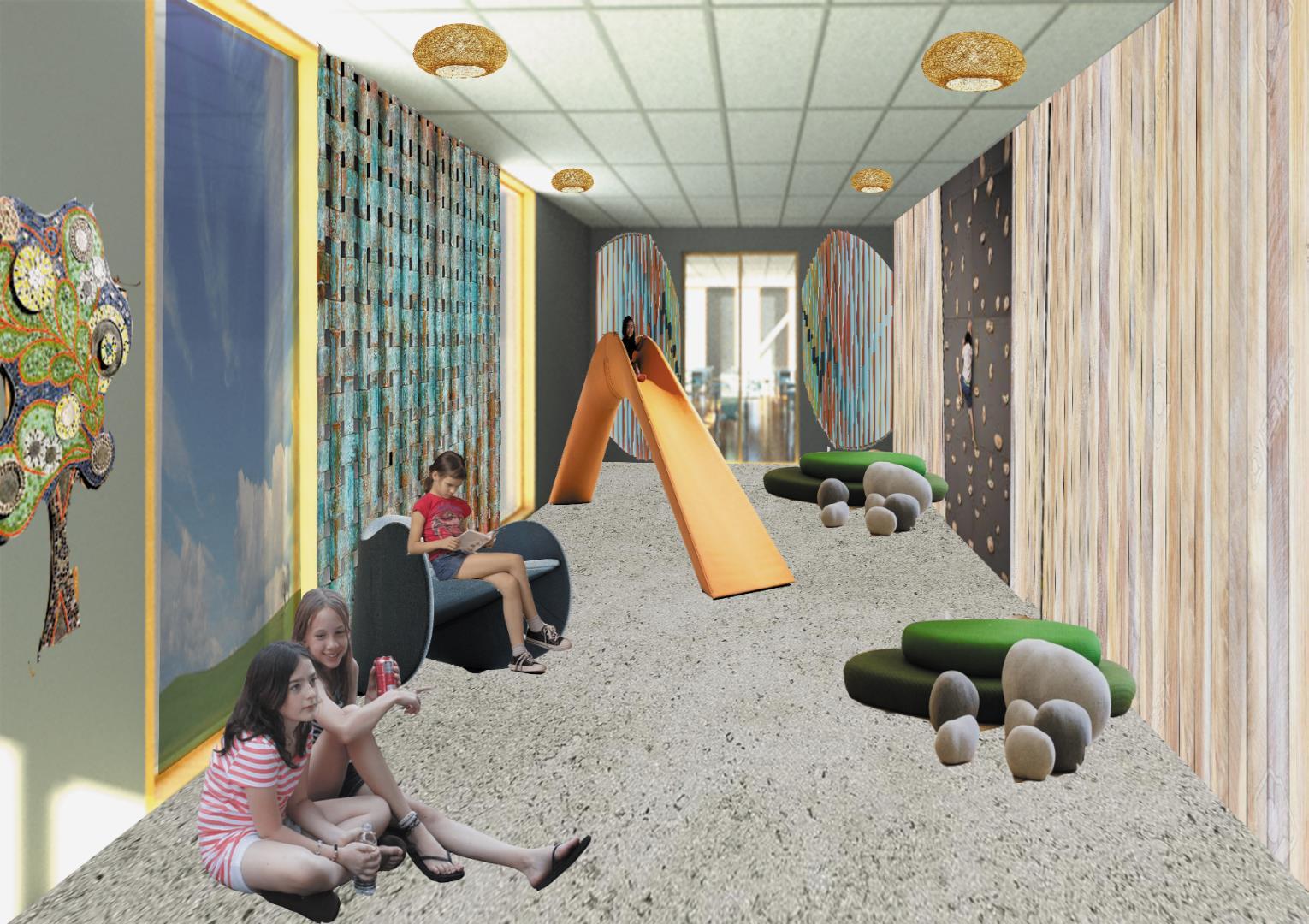
INDOOR PLAYSCAPE
Biophilic Design
and the Possible Positive Effect Upon School
Performance, Grad. Student Susan A. Khan C. Final Design Documents
Outdoor playscape included biophilic design features that have been shown in the studies to have the most significant positive effect upon executive functions and achievement scores included: challenges, pathways, rocks and boulders, loose parts such as logs and twigs to manipulate and problem solve, oval and rounded shapes, greenery, unmanicured gardens and a water feature. Illustrated are several different iterations of a playscape containing these features.
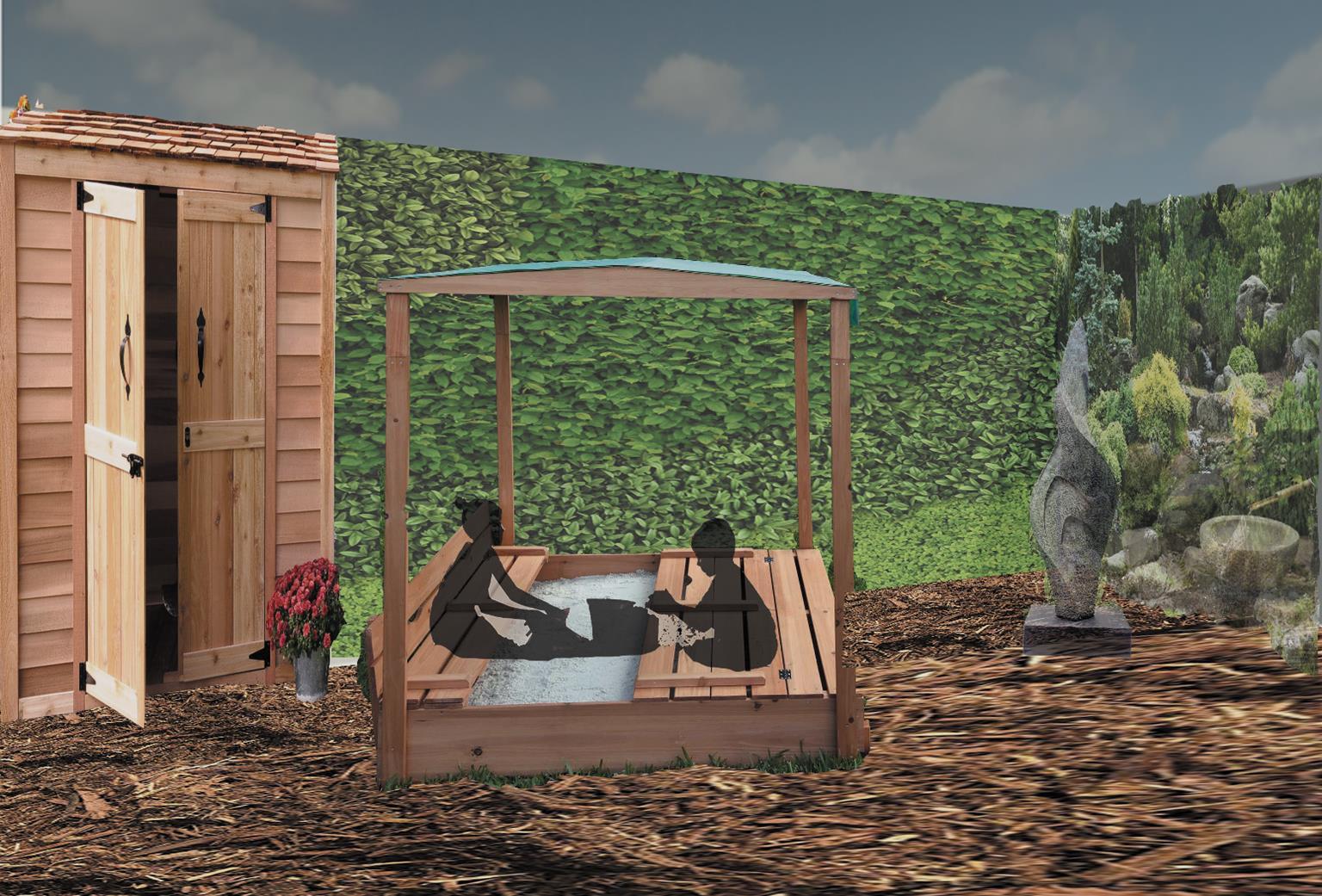
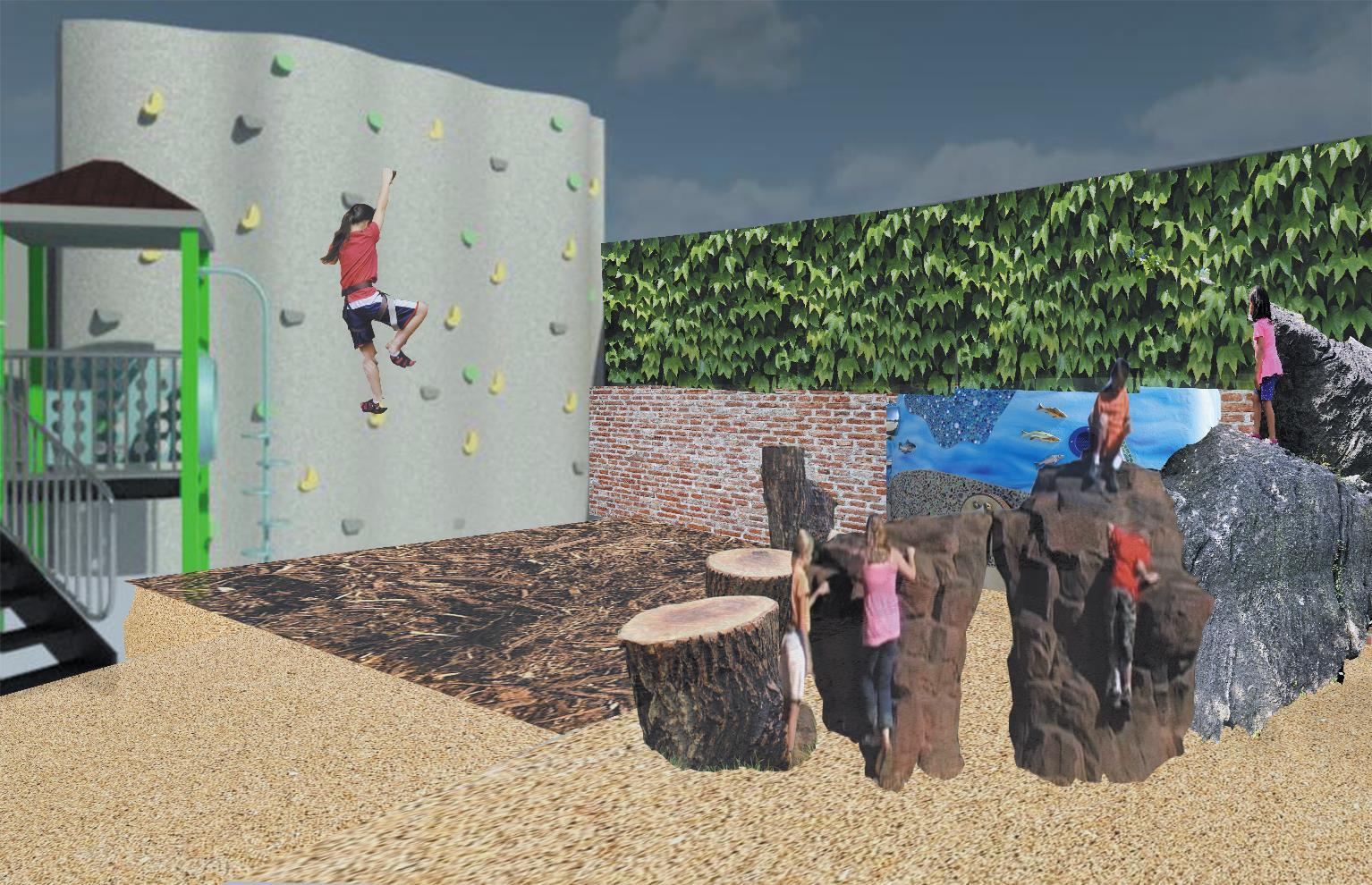
Biophilic Design and the Possible Positive Effect Upon School Performance, Grad. Student Susan A. Khan
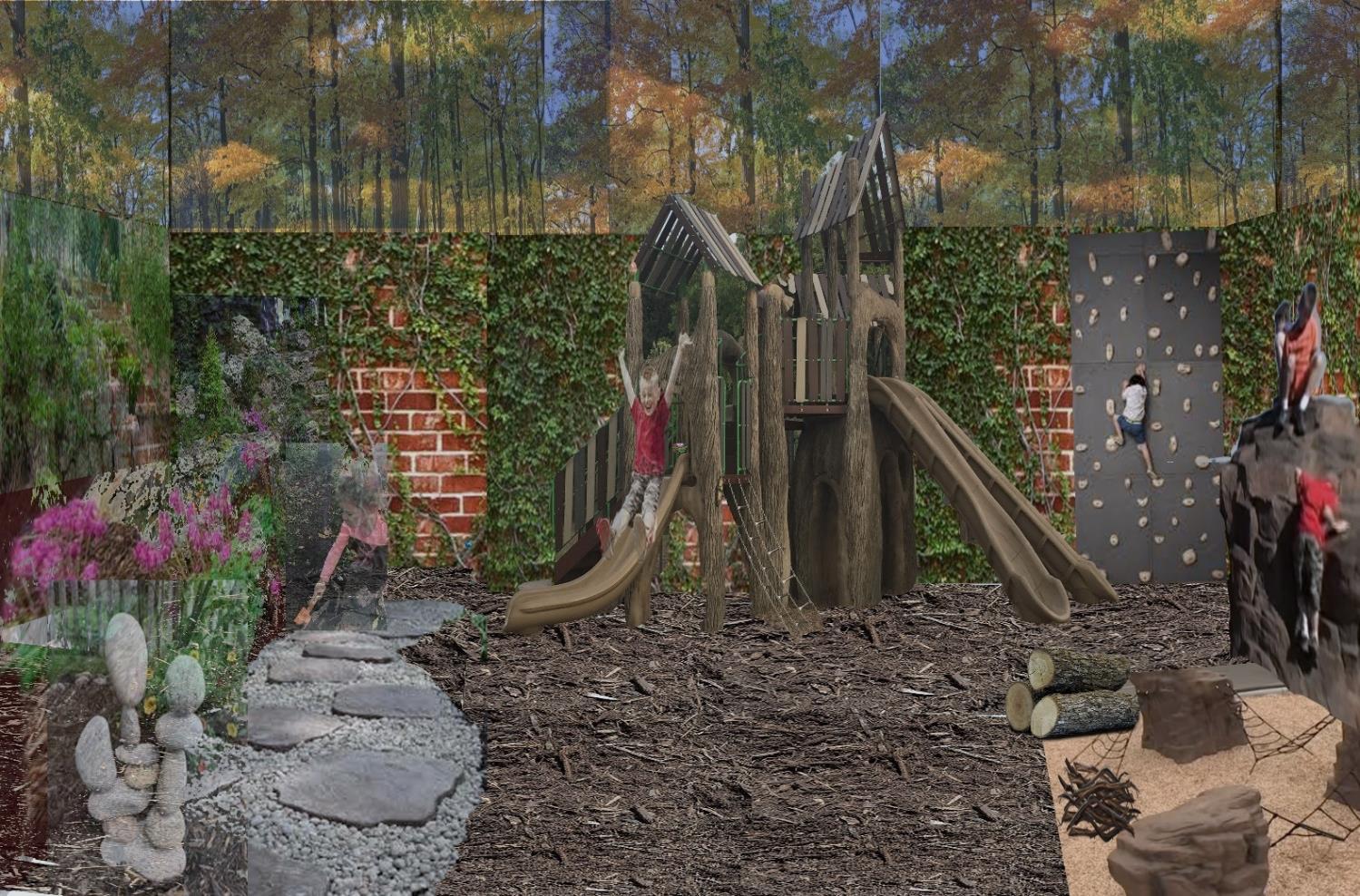
C. Final Design Documents OUTDOOR PLAYSCAPE

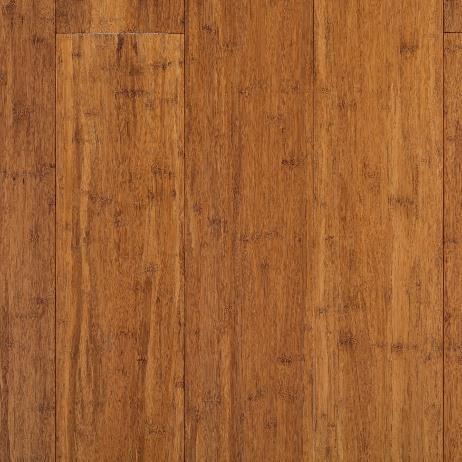
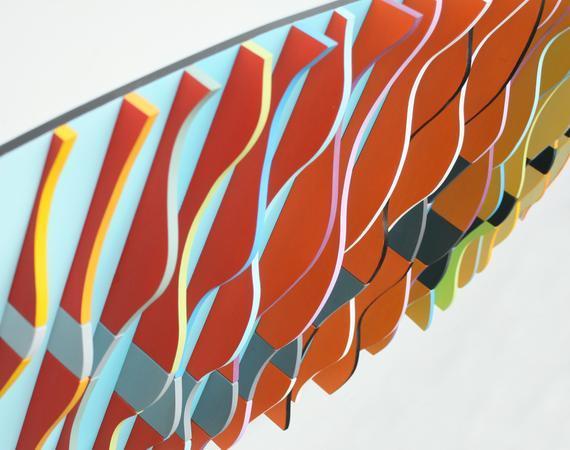
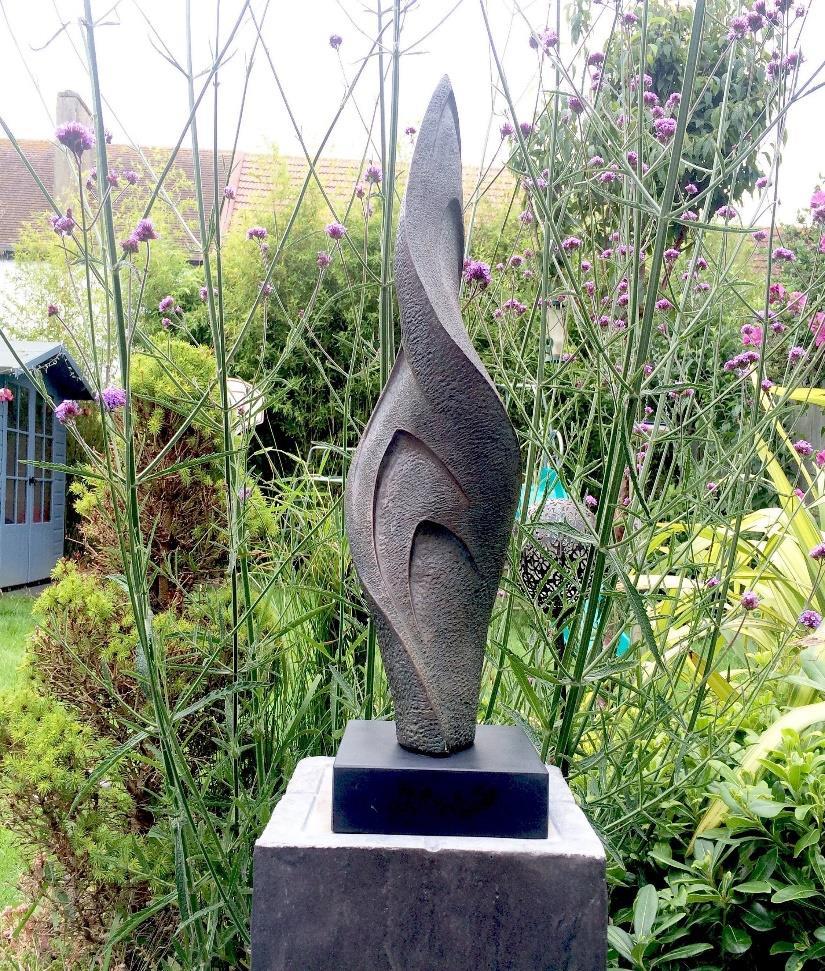

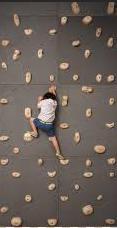
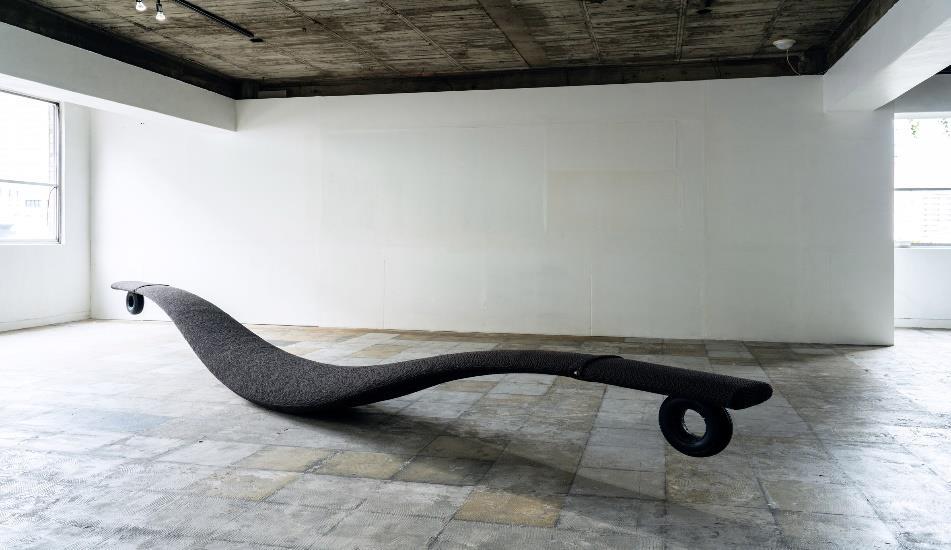

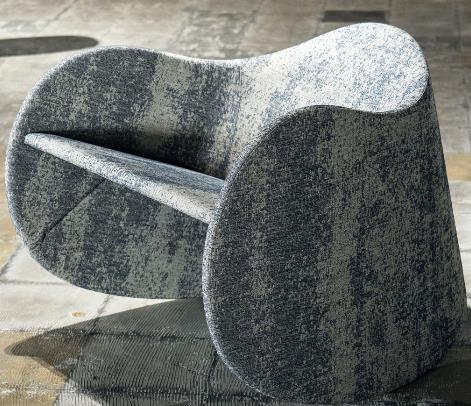

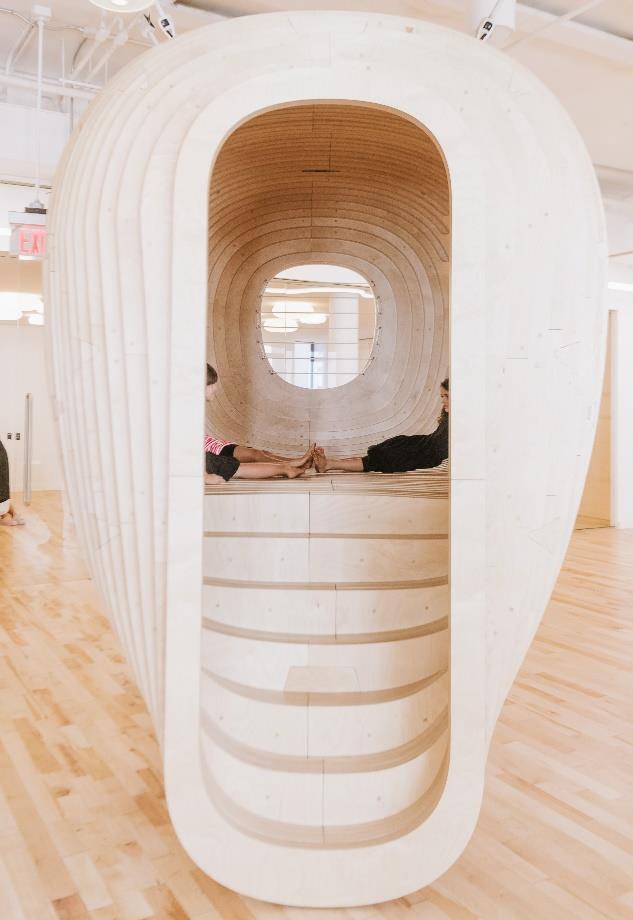
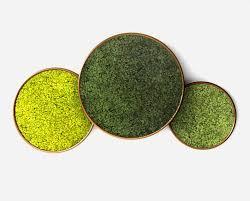

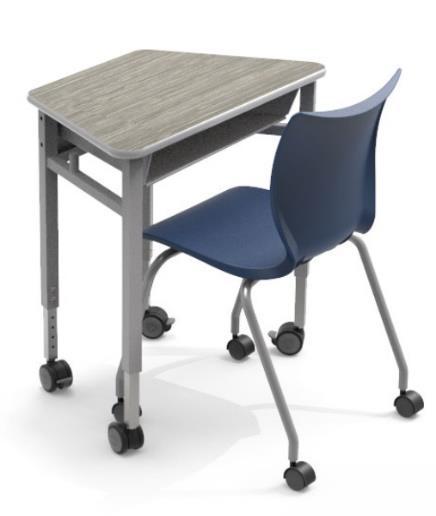


Furniture & Materials
Biophilic Design and the Possible Positive Effect Upon School Performance, Grad. Student Susan A. Khan
C. Final Design Documents

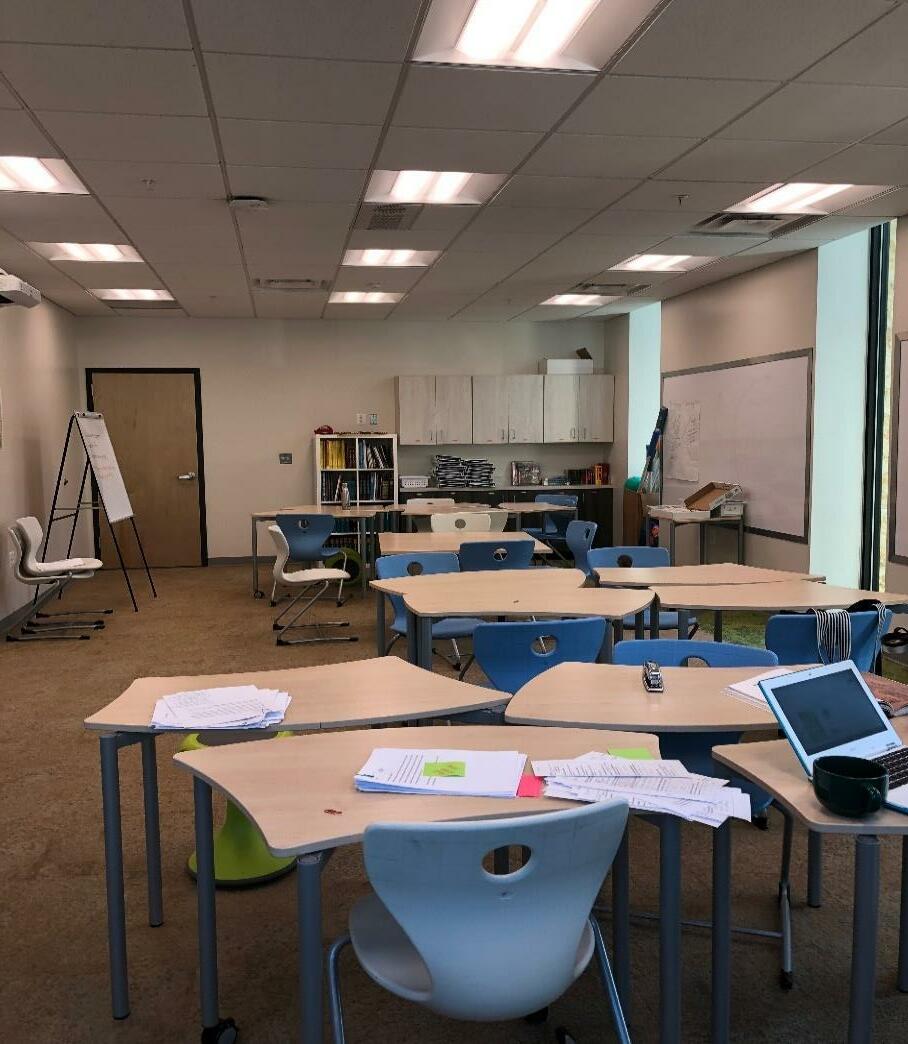

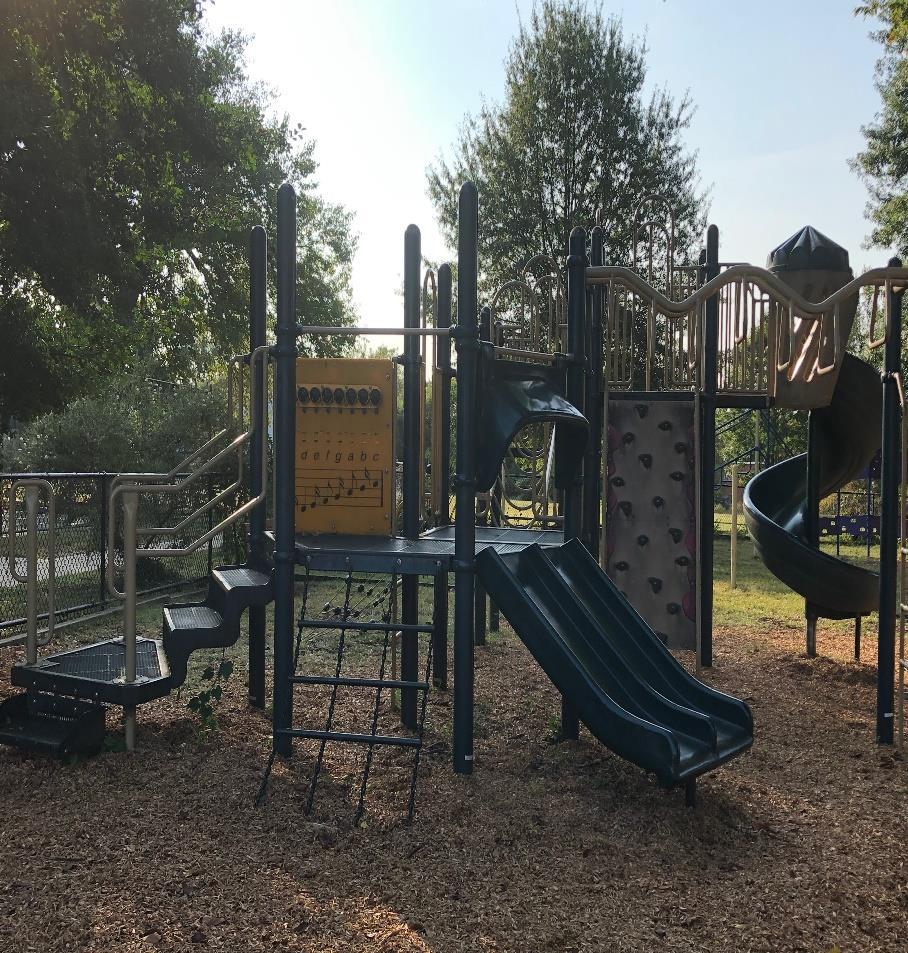
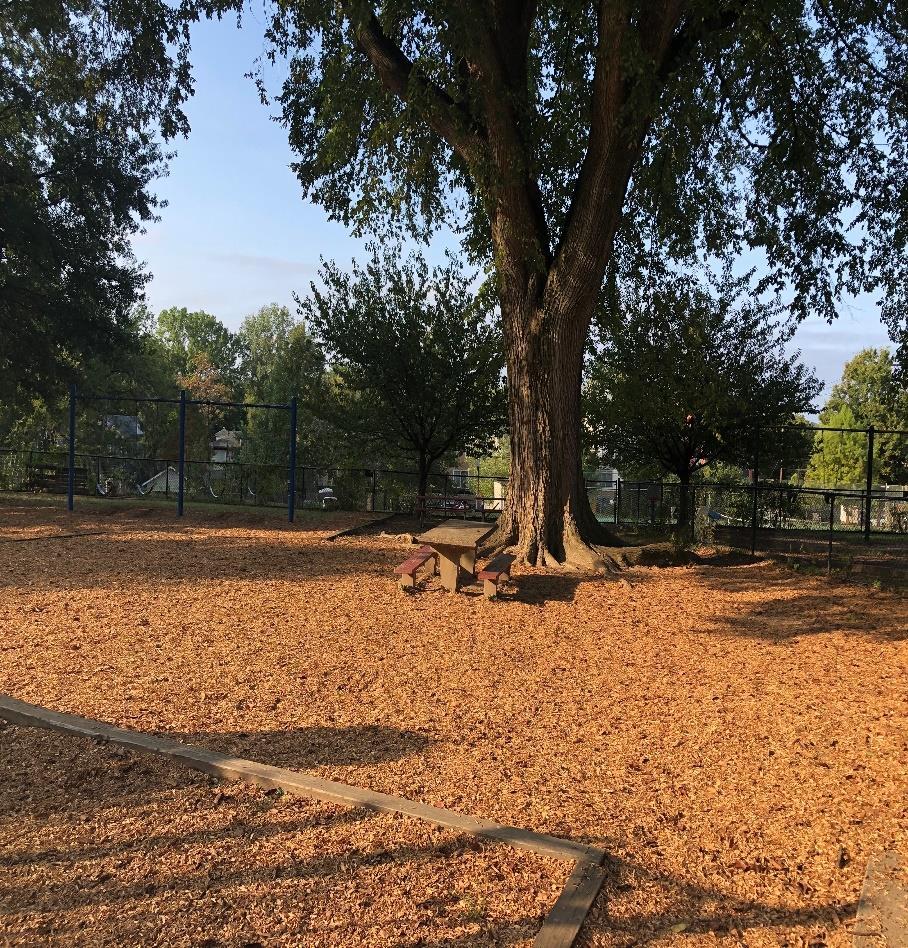

ST. PATRICK’S MIDDLE SCHOOL, WASHINGTON DC-CLASSROOM PROTOTYPE
PLAYSCAPE
Best Selves Through Nature

We Communicate Our
